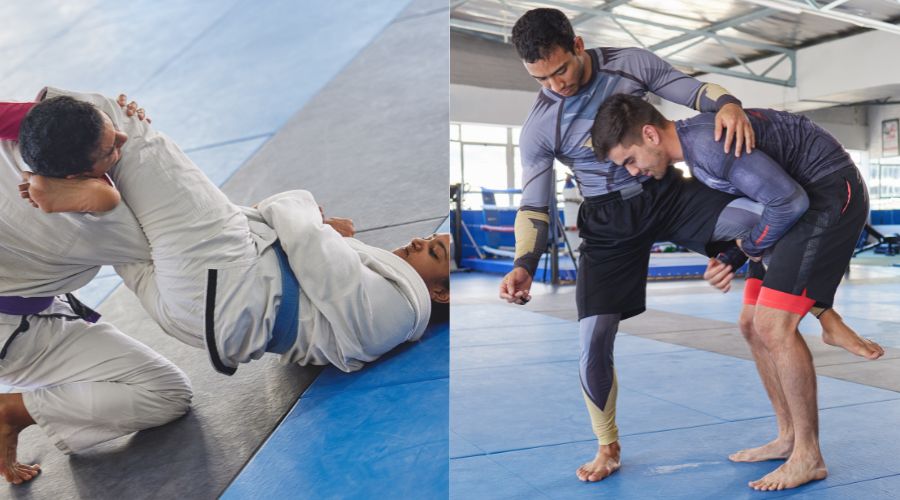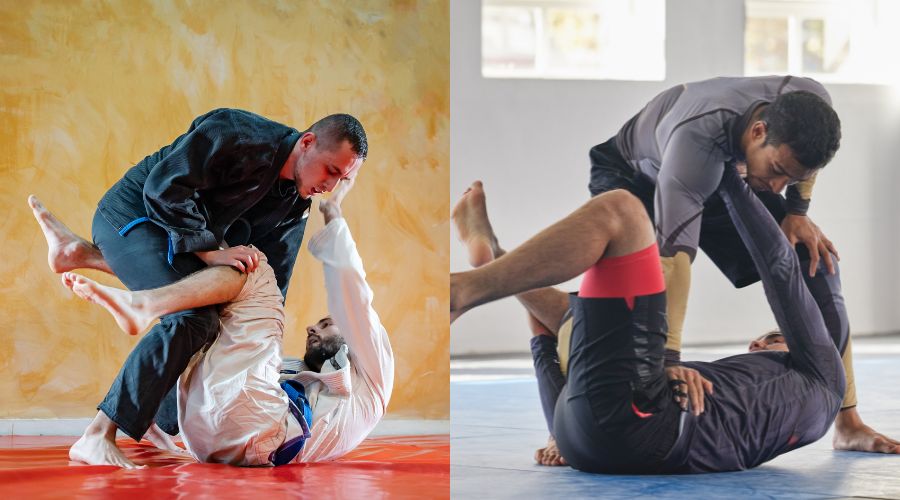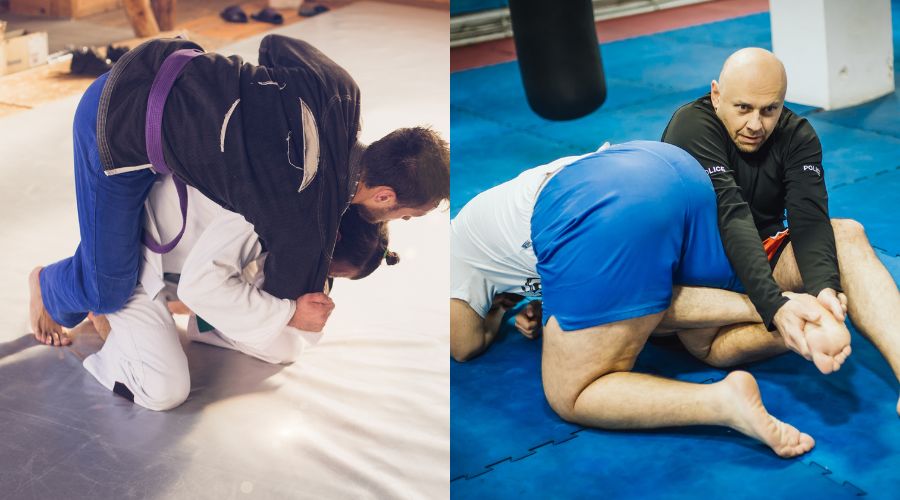Brazilian jiu-jitsu started as a self-defense fighting system created to defeat all others through grappling. But in the last few decades, different sub-styles have emerged, including a highly competitive grappling-only combat sport. Now, this sport is further divided into gi and no-gi BJJ. But do you know what the difference is?
Traditional gi Brazilian jiu-jitsu is practiced in a uniform called a gi or a kimono, which can be grabbed and manipulated during grappling, allowing for specific grips and submissions only available with a gi. In No-gi, on the other hand, practitioners wear tight shirts and shorts and are not allowed to grab them, creating a faster-paced grappling style.
The debate over which style is better among the BJJ community is fierce. Knowing all the details and intricacies will make your choice between the two much easier and better informed.
Key Differences Between Gi and No-Gi BJJ
Clothing
The most apparent difference determining all the others is the clothing in which the two styles are practiced. Traditional BJJ is practiced with a uniform called a gi or a kimono. It consists of a heavy jacket, trousers, and a belt indicating the practitioner’s rank.
The key here is not how it looks but how it can be used and manipulated while grappling. You can grab the sleeves, lapels, legs, and every part of the gi, your own or the opponents.
No-gi does not use a kimono but regular clothing, most commonly skin-tight compression shirts, rash guards, shorts, or BJJ spats made from synthetic materials. The clothing is form-fitting because you cannot grab it anytime during no-gi grappling.
These two styles of BJJ also mirror two of the main separations in general wrestling, where you have styles like Olympic wrestling, where you cannot manipulate clothing, and styles like judo and sambo, where you can.
Available Techniques

The gi can be used for control, attack, and defense and introduces many techniques and positions absent in no-gi BJJ. Establishing, stripping, and re-establishing gi grips is a crucial element of traditional BJJ that slows the tempo.
These grips are missing from the no-gi version. Instead, grapplers must rely on the natural grips available on the human body, like under and over hooks and wrist control. The lack of grips makes no-gi much more dynamic and reliant on takedowns and transitions.
On the submission front, the gi version again offers a greater number of available techniques. Especially the lapel of the gi allows for several strangles not possible otherwise.
Competition Rules
Aside from the big one where the clothing can be grabbed in gi BJJ, there are a few other changes in completion rules from one style to the next. The most prominent organization, called the IBJJF, has a lot of restricted techniques for different rank levels in gi competitions. At the same time, no-gi rules are usually a lot more liberal.
A key difference is the allowance of heel hooks and other leg locks in no-gi. At the same time, in the traditional style, they are reserved only for the brown and black belts, and only since recently.
Other organizations like the ADCC, considered the Olympics of grappling, have fewer forbidden techniques and leave the gi as an option. Still, then they are not considered strictly BJJ but rather submission grappling.
Physical Requirements
The different dynamics of gi and no-gi BJJ require a slightly different strength and conditioning profile. The gi allows physically weaker people to beat larger and stronger ones through grappling because the grips and positions can negate many strength advantages.
Then, if you are tired, it’s easier to control someone by grabbing a lapel or a sleeve, regardless of whether you are on top or bottom. This comes with a huge amount of grip strength, which is not needed or developed to the same extent in no-go grappling.
The lack of cloth grips and extra traction from a gi in no-gi makes the style much faster. It necessitates more strength, more cardiovascular endurance, and more explosive power. Generally, the physical demands in no-gi BJJ are higher, and a better strength and conditioning program is required for optimal results.
Both styles require a combination of strength, agility, balance, coordination, and endurance, so supplementary strength training is necessary to be competitive in all versions of BJJ.
Is Gi or No Gi Better for Self Defense

Things on the self-defense front are not so clear, and debate is ever-raging. Initially, BJJ was created as a comprehensive self-defense system, and worked perfectly. But street clothing has changed drastically in the past 100 years, and people are no longer always wearing suits and jackets like they used to.
No-gi is often better for self-defense because you learn not to rely on gi grips and techniques and use stuff that works on everyone. In warmer countries where t-shirts, BJJ shorts, and linen shirts are what most people wear most of the time, no-gi is much better.
On the other hand, the training gi is just like a heavy jacket and jeans. In cases where the attacker has thick clothing, knowing how to use it to your advantage is much better.
Generally, no-gi BJJ is more practical in many situations in the modern world, and the intensity and pace are much more similar to that of a street fight.
Is Gi or No Gi Better for MMA
Unlike the debate over self-defense effectiveness, the answer to which is better for MMA is clear, and that is no-gi. In fact, one might argue no-gi BJJ became a thing mainly because of how vital jiu-jitsu is to mixed martial arts.
The answer is simple: gi techniques do not work in MMA, and no-gi dynamics are much closer to those of mixed martial arts. Instead of spending much time learning techniques with a gi, your time is infinitely better spent learning things you will be able to do in the cage if your main training focus is MMA.
Is Gi or No-Gi Better for Beginners

While there are varied topics on the matter, more people lean towards the opinion that gi BJJ is better for complete beginners if their goal is only grappling. The slower pace, higher friction provided by the gi, grips helping you take a breath during grappling, and lower physical demand make it easier for people to get into.
Furthermore, these qualities of BJJ reinforce more solid fundamentals, keep you from relying on strength or speed, and force you to learn proper positioning and technique. These are all things that are very important for your long-term success in grappling.
But if your goal is self-defense or MMA, then in my opinion, there is no need to spend the time in gi, and you can directly start with no-gi as it will teach you the skills you need for MMA fighting.
Gi Pros and Cons
To summarize this article, we will list each style’s main pros and cons. Finally, the best strategy is to train in both and become a well-rounded grappler. Once you have experience, you can choose what to prioritize based on your goals, preferences, and fitness level.
Pros
- Most skills transfer to no-gi
- More tactical due to the slower pace and tighter grips
- Develops incredible grip
- Requires fewer physical attributes
- More technical with more submissions and techniques
Cons
- Not realistic with less clothing
- Not as applicable to MMA
No GI Pros and Cons
Pros
- Better for most self-defense scenarios
- Builds better fitness
- Much more relevant to MMA
- Higher paced and more dynamic
- You can be very good with fewer techniques
Cons
- Requires better fitness
- If you want to compete in gi, you need to learn much more techniques
